
All categories
Featured selections
Trade Assurance
Buyer Central
Help Center
Get the app
Become a supplier

(2252 products available)





















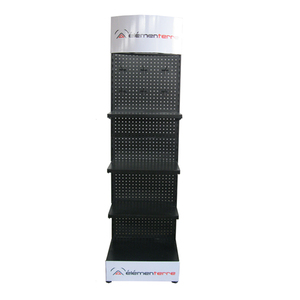









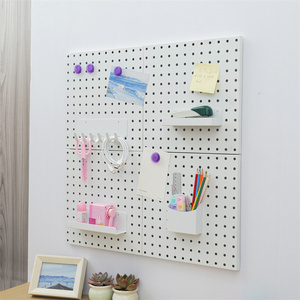
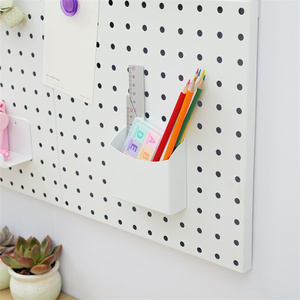
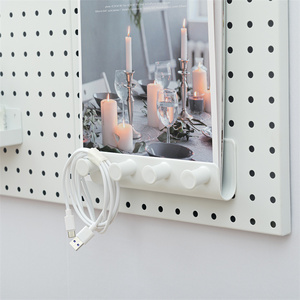
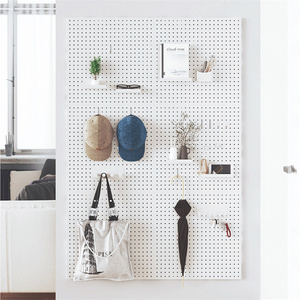
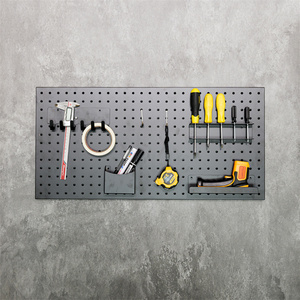

A tool organizer pegboard is a wall-mounted panel system with regularly spaced holes for hanging tools and equipment. It helps keep tools organized and easily accessible, reducing clutter and saving time. Various pegboards are available in the market, each with unique features and suitability for different needs. Some of the most common types are as follows:
Metal pegboards
Metal pegboards are made of strong steel that is coated with powder for protection. They are very durable and can hold heavy tools without bending. Metal pegboards do not break easily and can last a long time. They are also easy to clean and maintain. Metal pegboards can be used in many places, like workshops, garages, or schools, to store tools, supplies, or things neatly. They help keep everything organized and within reach.
Wooden pegboards
Wooden pegboards are designed to keep tools and other things organized in workshops, garages, or schools. They are made of wood and have holes for hooks, shelves, and brackets to hang tools on. Wooden pegboards are good for hanging lightweight items like hand tools and crafting supplies. They are not as strong as metal ones, so they are best for lighter things. Wooden pegboards can be written on or painted to help identify stored items. They are simple to install and adjust. People like wooden pegboards because they are inexpensive and blend in with any space.
Plastic pegboards
Plastic pegboards are made from a strong plastic material called high-density polyethylene (HDPE). These pegboards are lightweight, resistant to moisture, and do not rust or corrode, making them suitable for use in humid environments or areas exposed to chemicals. Plastic pegboards are easy to clean and maintain, and their surface can be wiped down to remove dirt or stains. They are simple to install, often coming with various mounting options, and are safe for use in schools and other public places.
Perforated metal panels
Perforated metal panels are large panels made of metal with small holes punched into them. These panels can be hung on walls or freestanding frames to organize tools. The holes in the panels allow for hanging items using hooks, pegs, shelves, and bins. Perforated metal panels are strong and can hold heavy things well. They are suitable for workshops, garages, and factories where many tools need to be stored safely and efficiently. These panels help keep items visible and orderly, making it easier to find and put them away.
Magnetic pegboards
Magnetic tool pegboards use the attraction of magnets to hold and organize tools. These pegboards have a metal surface with magnets behind it. Tools with metal parts can be hung on the pegboard using magnetic tool holders or directly if the tool itself has a magnetic feature. Magnetic pegboards are convenient for quickly accessing and storing tools. They are often used in places like workshops, labs, and kitchens where keeping tools within reach is important. Some magnetic pegboards also have hooks and shelves for storing non-magnetic items, making them versatile for organizing different tools and supplies.
Size and Shape
Tool organizer pegboards come in various sizes and shapes to accommodate different needs and preferences. They can be small and square, large and rectangular, or even custom-made to fit specific spaces. This variety allows users to optimize their storage and organization systems.
Material
Most pegboards are made from durable materials such as medium-density fiberboard (MDF), metal, or plastic. MDF pegboards are lightweight and easy to customize, metal ones are strong and resistant to rust, while plastic pegboards are waterproof and easy to clean.
Color Options
Tool organizer pegboards are available in a range of colors to enhance aesthetics and functionality. Common colors include white, black, gray, and green, but they can also be found in bright and vibrant shades to add a playful touch to the workspace.
Texture
The texture of the pegboard can influence its performance and appearance. Some pegboards have a smooth texture for easy cleaning and maintenance, while others have a rough texture to enhance the grip and stability of the hooks and shelves.
Hole Pattern
The hole pattern on the pegboard is crucial for its functionality. Standard pegboards have uniformly spaced holes in square or rectangular patterns, while some boards offer perforated designs for more versatility in organizing tools and accessories.
Edge Design
The edge design of the pegboard can affect its installation and safety. Some pegboards have beveled edges to facilitate installation, while others have rolled edges to prevent injuries from sharp edges.
Back Design
The back design of the pegboard can influence its stability and ease of use. Some pegboards have reinforced backs to increase their strength, while others have pre-drilled holes for easy mounting on walls.
Tool organizing pegboards are used in different settings to keep tools in order and make workspaces neat and safe. These pegboards are helpful in many industries and can be used in several ways.
Industry
In factories and large shops, metal pegboards with hooks for tools are used to hang tools. This helps workers find tools quickly and return them to the right place, which reduces accidents and tool damage. It also helps keep the area clean and organized.
Maintenance and repair
Maintenance and repair teams use pegboards to keep their tools visible and reachable. When technicians have their tools organized on a pegboard, they can work faster and reduce the risk of leaving tools in machines or vehicles.
Construction
Construction sites require portable pegboards for keeping hand tools, measuring devices, and safety gear. Pegboards make it easy to carry tools around the site and help ensure that tools are always where they should be for safety.
Automotive shops
Automotive repair shops use pegboards to organize diagnostic tools, wrenches, and other hand tools. This arrangement allows mechanics to quickly access the tools needed for repairs, improving efficiency.
Gardening
Gardeners can use pegboards to hang pruning shears, trowels, and other gardening tools inside sheds or outdoor workshops. This keeps everything tidy so that gardeners can easily find what they need when working in their gardens.
Crisis management
Diy enthusiasts use pegboards to keep crafting tools, paints, and brushes neat for better project management. Pegboards allow them to display supplies neatly so that they can experiment with different ideas without wasting time searching through boxes or drawers.
Wholesale buyers need to consider these factors when selecting pegboards and tool organizers.
Compatibility with Existing Systems
Check if the new pegboards fit with existing panels and hooks. Choose boards with the same hole size and spacing. It helps maintain consistency across the workshop. A board that fits existing panels will save users time. They don't have to replace old panels or buy new hooks.
Tools and Equipment
Identify which tools the pegboard will hold. Select boards that support heavy tools for workshops with many power tools. Light boards are suitable for holding hand tools. They are lighter and don't need as much strength.
Material and Durability
Choose metal pegboards for workshops that need high durability. Metal can withstand the impact of heavy tools. Vinyl boards are suitable for light use and are more affordable. They are also easier to maintain and clean.
Installation and Maintenance
Select pegboards that are easy to install. Consider the number of people and the skills needed for installation. Opt for pegboards with minimal maintenance requirements. They save users time and cost in the long run.
Safety Considerations
Ensure the pegboard can support the weight of the tools. Choose boards with more holes for better weight distribution. Select boards with smooth edges to prevent cuts during tool retrieval.
Cost
Consider the pegboard's cost and its long-term benefits. Vinyl boards are cheaper but may need replacement sooner than metal boards. Balance the upfront cost with the durability and maintenance expense.
Q1. What are the benefits of a tool organizer pegboard?
A1. Pegboards create more storage space, make it easy to find tools, and improve efficiency. They also help keep the workspace clean and organized and enhance safety by minimizing the risk of accidents due to misplaced tools.
Q2. What is the standard spacing between holes in a pegboard?
A2. The standard spacing between holes in a pegboard is typically 1 inch. However, there are pegboards with 1.5-inch hole spacing, which is less common but can accommodate larger hooks and accessories.
Q3. How can one install a pegboard wall?
A3. To install a pegboard wall, choose a location, gather tools, and materials, and cut the pegboard to size. Next, attach the pegboard directly to wall studs or use furring strips, drill holes, and install pegs.
Q4. Can a pegboard be used in different areas of the home?
A4. Yes, pegboards can be used in various areas of the home, such as the garage, workshop, crafting area, or even the kitchen and home office, to organize tools, supplies, and equipment.
Q5. What accessories are available for pegboards?
A5. Many pegboard accessories are available, including hooks, shelves, bins, brackets, and tool holders, which help customize the pegboard system to organize different items effectively.